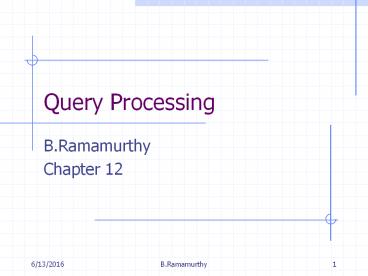Query Processing - PowerPoint PPT Presentation
Title:
Query Processing
Description:
Query Processing B.Ramamurthy Chapter ... query-optimization transformations, and actual evaluation of queries. ... Query execution engine evaluates the query. – PowerPoint PPT presentation
Number of Views:191
Avg rating:3.0/5.0
Title: Query Processing
1
Query Processing
- B.Ramamurthy
- Chapter 12
2
Introduction
- Query processing refers to activities including
translation of HLL queries into operations at
physical file level, query-optimization
transformations, and actual evaluation of
queries. - Objective of most query processing algorithms is
to reduce the number of disk access which
dominates the cost of query processing.
3
Query Processing Steps
- Parsing and translation checks the validity and
translates to relational algebraic expression. - Optimization analogous to algebraic
simplification - Evaluation many ways of evaluation.
4
Steps in Query Processing
Parser Translator
Relational Algebra Expressions
Query
Stats about data
Optimizer
Evaluation Engine
Query Output
Execution Plan
data
data
5
Query Processing Steps Example
- Select balance
- From account
- Where balance lt 2500
- Can be translated into either of the following
- s balance lt 2500 ( p balance (account))
- p balance (s balancelt 2500 (account))
6
Evaluation
- To specify how to evaluate the query we need to
provide relational algebra expressions as well as
annotate it with how to evaluate each operation. - This annotation is known as evaluation primitive.
- Several primitives together form a pipeline.
- A sequence of primitives together form a
query-execution plan or query-evaluation plan. - Query execution engine evaluates the query.
7
A Query-evaluation Plan
p balance
s balancelt 2500
account
Different evaluation plans will have different
costs. It is Upto the system to decide the most
efficient plan.
8
Query Optimization
- Query optimization is the process of selecting
the most efficient query evaluation plan for a
query. - Optimizers use statistical data about relations
such as relation sizes and index depths to make a
good estimate of cost of a plan. - We will look at cost model, cost of individual
operations selection, sorting, join, and other
operations.
9
Catalog Information
- Relevant catalog information about relations
includes - nr , number of tuples in the relation
- br , number of blocks containing relation r
- sr , size of a tuple of relation r in bytes
- fr , blocking factor, number of tuples/block
- V(A,r), number of distinct values that appear in
the relation r for attribute A. - SC(A,r), selection cardinality of attribute A of
relation r. Average number of records that
satisfy equality condition for attribute A. 1 if
A is key attribute, A(A,r) / nr for one
distributed evenly.
10
Information about indices
- Information about the indices are also maintained
in the statistical database - fi , average fan out of internal nodes in a B
tree index. - HTi , number of levels of the index tree.
- LBi , number of lowest level index blocks in the
index tree. - All stats are usually registered for during DB
updates.
11
Measures of Query Cost
- Disk access dominates the cost.
- Assume all transfers of blocks cost the same.
- Number of block transfers from the memory for
query will be the measure we will use. - Cost also depends on main memory buffer. We
assume 1 block / relation main memory buffer.
12
Selection Operation
- Selection using linear search
- Selection using binary search
- .. Using indices primary and secondary
- Selection involving comparisons
- Implementation of complex selections
13
Join Operation
- There are several algorithms available for
computing join. - Lets analyze and compare them.
14
(No Transcript)
15
(No Transcript)































